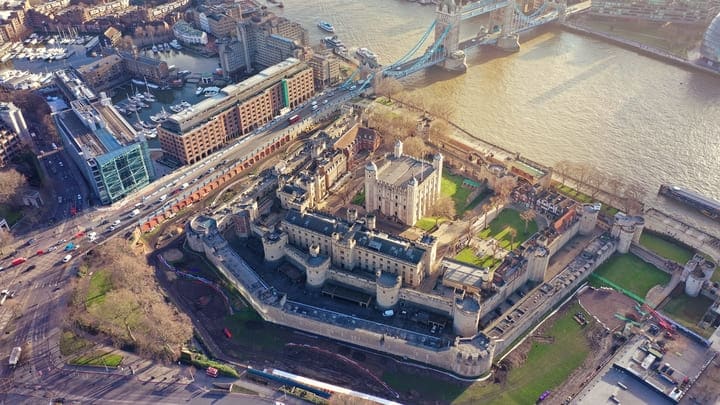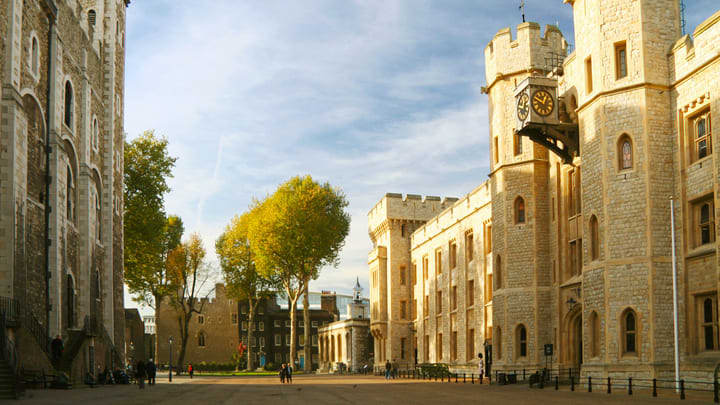10 Facts About the Tower of London You Never Knew | The London Pass®
by Mia Russell
A fortress, a palace, a prison. The Tower of London has a long and macabre history as a place of imprisonment and incarceration. From being the execution site of queens, whose ghosts are said to still haunt its halls, to the current home of the Crown Jewels, the Tower of London has a wealth of secrets begging to be explored.
Let’s dive right in to discover some fascinating facts about the Tower of London, as well as some curious mysteries.

1. The Tower of London Is Not Its Official Name
Founded by William the Conqueror in 1066, this historic castle is based in the heart of London and is one of the world's most iconic and recognizable landmarks. However, the Tower of London is not its official name. The building’s official title is Her Majesty’s Royal Palace and Fortress of the Tower of London.

2. The Tower of London Was London’s First Zoo
Before the Tower became a prison for humans, it was a prison for animals in the form of London’s first zoo. Known as the ‘Royal Menagerie,’ the Tower housed the royal collection of wild and exotic animals that were gifted to the kings and queens that reigned.
Seeing African elephants, lions, tigers, kangaroos, ostriches, and a polar bear roaming around the grounds wasn't unusual. In 1835 the Duke of Wellington closed the menagerie, and the animals were moved to grounds in Regent’s Park that later became the London Zoo. Today, all that is left of the animals at the Tower are the resident ravens and sculptures of lions and other animals dotted about the grounds.

3. The Tower is Home to the Crown Jewels
One of the many unique attractions at the Tower of London is the Crown Jewels. Officially known as Royal Coronation apparel, the Crown Jewels have been safely stored in the Tower of London since the 15th century.
The collection includes some of the world's most valuable and historic jewels, such as the Imperial State Crown, which the monarch wears at the State Opening of Parliament. The Imperial State Crown boasts 23,578 gemstones and is thought to have a value of between two and four billion pounds!
Other items kept in the Tower include royal robes and jewelry, which are brought out and sent to Westminster Abbey when a new King or Queen is crowned.

4. Resident Ravens are the Guardians of the Tower
Ravens have long been a part of the Tower’s history and are protected by royal decree. When Charles II wanted the ravens removed, he was told that the monarchy would fall, so the ravens stayed and have called the Tower home ever since.
The ravens are cared for by the Tower's raven master, who will regale stories of their role throughout history when you enjoy a free tour of the Tower of London with your pass.

5. The Real Guardians of the Tower are the ‘Beefeaters’
The famous Yeoman Warders have guarded the Tower of London since the 16th century. Also known as the ‘Beefeaters,’ these ceremonial guardians of the Tower were responsible for safeguarding the British crown jewels and looking after any prisoners in the Tower.
Today, Yeoman Warders are selected for their outstanding service in the Armed Forces. They still play the ceremonial role of guardians to the Tower and provide information and guided tours to visitors as they have done since the Victorian era.
Why the name ‘Beefeaters’? The odd name stems from Henry VII, whose personal guards were the first ‘Beefeaters,’ as they were allowed to eat as much beef as they wanted from the King's table.
The bright red and black uniforms of the Yeoman Warder include pure gold thread and are estimated to cost over £7,000 each!
6. The Oldest Military Ceremony in the World Takes Place Every Night
The Tower gates are locked in a historic military tradition known as the Ceremony of The Keys every evening. At precisely 9:53 pm, the Chief Yeoman Warder, accompanied by an armed escort of the Queen’s Guards, set off to lock all the gates carrying a lantern in one hand and the Queen’s Keys in another.
The evening ritual has continued for over 700 years without fail – the faithful Yeoman Warders did their job for Queen and country throughout the Great London Fire, the Plague, and both World Wars.

7. The Tower was Never Meant to be a Prison
The long and gruesome history of the Tower as one of the most brutal prisons in England and a place of execution was never planned. The Tower was built primarily as a secure fortress to showcase royal power.
Soon, however, the Tower became home to anyone who threatened the Royals or the country. Many famous historical figures were held prisoner within its walls, including Anne Boleyn, Catherine Howard, Sir Walter Raleigh, and Queen Elizabeth I.
Many were also executed and murdered here, including the two boy princes, Edward V and Richard. The last execution in the Tower of London occurred in 1941 when a firing squad shot German spy Josef Jakobs.
Use your pass to tour the Tower of London and explore the dark dungeons and freezing towers where prisoners were held.
8. The Tower is Thought to be Haunted
The fortress’ ominous 1,000-year history of horrific torture and bloody executions is thought to have left the spirits of those who died to haunt its stone passageways. The ghosts of Lady Grey and the Countess of Salisbury are believed to be here, as well as those of the twins that were murdered in the Bloody Tower.
The most famous ghostly figure is that of Anne Boleyn, Queen of Henry VIII, who was beheaded in 1536 on Tower Green after giving birth to a stillborn son. Anne is often spotted wandering the grounds carrying her severed head and a grizzly bear from when the Tower was a zoo!

9. The Tower was a Military Base During Both World Wars
During World War I and II, the Tower of London transformed into an impenetrable military base.
During WWI, the moat around the Tower was used as a training ground for recruits. Today, the headquarters of the Royal Fusiliers Regiment is still based at the Tower.
During the Second World War, Rudolf Hess, the infamous Nazi prisoner of war, was held prisoner at the Tower after crash landing in London during a flight to Scotland and being captured. Twelve enemy spies were also executed here during the war.

10. The Tower was Bombed During World War II
During World War I, only one bomb fell on the Tower, landing harmlessly in the moat. During World War II, however, the Tower was devastated. High-explosive bombs found their target during the Blitz in 1940, destroying several buildings. One of the towers completely collapsed into the moat below it.
After the war, the damage was thankfully repaired, and the Tower opened to the public once again.
Plus, don't forget to save...
So there you have it, our top ten most interesting facts about the Tower of London – don't forget to save on your entry to this and other top London attractions with the London Pass®.
